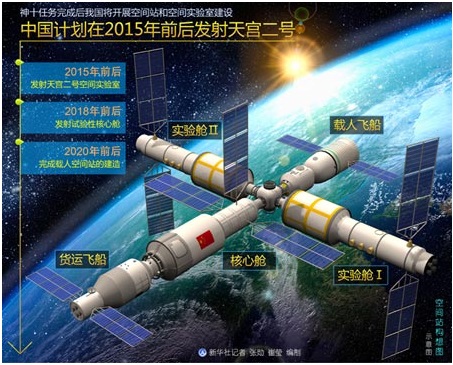In March of 2013, a presentation was made on China's future in space to the People's Congress and the Communist Central Committee. The presentation included an optimistic plan for a permanent space station and exploration beyond the Earth.
The International Space Station is expected to be retired by 2020. China is planning on completing its first permanent space station in the same year. Unless another nation establishes a space station in the meantime, the Chinese station will be humanities only orbital base. The chief designer of the space station said that the Tiangong-2 station will be "multi-cabin with a large capacity and high power." He said that it will be a national space lab with diverse and flexible experiments. He also said that "International cooperation will be encouraged and the door of the lab will be open for any experiments that fit the requirements."
A new cargo carrying space ship named Tianzhou is being designed to ferry materials and people to and from the station. China is planning on launching the cargo ship in 2016 to serve the Tiangong-2 space laboratory. The cargo ship will be launched into space on the new Long March-7 rocket. The ship will be able to dock with the Tiangong-2 automatically. The cargo ship is seen as the key to the development of the space station.
The Long March Rocket series is seen as the basis of an industrial launch capacity. China is planning for two hundred and seventy domestic launches and four hundred and sixty launches carrying foreign payloads by 2020.
The Yuanzheng-1 is a vessel that can be attached as a second stage to a carrier rocket from the Long March series. The Yuanzheng-1 itself can carry a spacecraft into orbit. It is also able to carry multiple craft into different orbits on one flight. The Yuanzheng-1 will play an important role in the exploration of the Moon and planets. It will also be useful for orbital transfers and could assist in dealing with space debris in Earth orbit.
Preparations are already under way for the 2017 launch of Chang'e 5, the third phase of China's lunar exploration. The Chang'e 5 rover will be able to dig up samples of lunar soil which will be returned to Earth for analysis. A Chang'e 5 test probe will be launched in 2014 as part of the preparations. In order to be successful, the Chang'e 5 will "require breakthroughs in moon surface takeoff technology, sampling encapsulation, rendezvous and docking in lunar orbit, as well as high-speed Earth reentry."
China is also looking ahead to launching satellites for the exploration of Mars and possibly even manned missions to Mars. The presentation to the Congress and Committee stated that the future of the human race lies beyond the Earth. It said that if the technological bottlenecks to human missions into space cannot be solved, then "the future of the whole species is bleak."
Tiangong-2 Space Laboratory:
